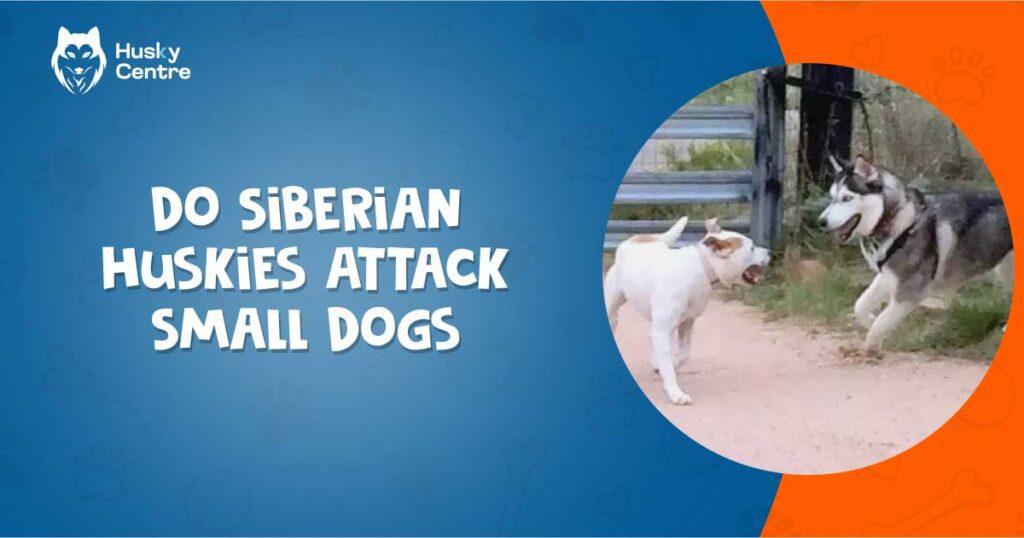Siberian Huskies may attack small dogs due to their high prey drive. Proper training and socialization can mitigate this behavior.
Siberian Huskies are known for their friendly and energetic nature. They are often great companions but have a strong prey drive. This instinct can sometimes lead them to chase or attack smaller animals, including small dogs. Owners must provide proper training and socialization to ensure harmonious interactions.
Early exposure to different animals and consistent obedience training can help manage their instincts. Understanding a Husky’s behavior and needs is crucial for a safe and happy environment. Owning a Siberian Husky requires commitment and knowledge to address their unique traits effectively.
Siberian Husky Temperament
When thinking about Siberian Huskies, their majestic appearance and striking blue eyes often come to mind. But how do they behave around small dogs? Understanding the Siberian Husky temperament is essential to addressing this question. This section delves into the nature of these beautiful creatures and their interactions with smaller animals.
Siberian Huskies And Their Playful Nature
Siberian Huskies are known for their playful and energetic nature. They love to run, jump, and play. This high energy can sometimes be overwhelming for smaller dogs.
These dogs often exhibit a strong prey drive. They might see smaller animals as something to chase. This behavior is rooted in their history as sled dogs.
Pack Mentality In Huskies
Huskies have a strong pack mentality. They enjoy being part of a group. This can make them very sociable but also competitive.
In a household with multiple pets, Huskies may try to establish their dominance. Smaller dogs might feel intimidated by this behavior.
Socialization And Training
Proper socialization is crucial for Huskies. Early exposure to different animals can help them behave better around smaller dogs.
Training plays a significant role too. Teaching your Husky basic commands and how to interact can prevent aggressive behaviors.
| Husky Traits | Impact on Small Dogs |
| High Energy | Can overwhelm smaller dogs |
| Prey Drive | May chase small dogs |
| Pack Mentality | Could lead to dominance issues |
Factors That Influence Behavior
Several factors can influence a Husky’s behavior towards small dogs. These include their upbringing, training, and individual personality.
- Upbringing: A well-raised Husky is usually more gentle.
- Training: Consistent training reduces aggressive tendencies.
- Personality: Each Husky has its own unique traits.
Understanding these elements can help in creating a harmonious environment for both your Husky and small dogs.
Factors Influencing Dog Aggression
Understanding whether Siberian Huskies attack small dogs involves examining various factors influencing dog aggression. These factors can shape a dog’s behavior and determine its interactions with other animals. By recognizing these elements, owners can manage and mitigate aggressive tendencies effectively.
1. Genetics and Breed Characteristics
Genetics play a significant role in shaping a dog’s temperament. Siberian Huskies are known for their strong prey drive. This instinct can sometimes lead to aggressive behavior towards smaller animals. Breed characteristics influence how they react in certain situations.
2. Socialization and Training
Proper socialization from a young age is crucial. Dogs exposed to various environments, people, and animals tend to be less aggressive.
Training helps in managing and reducing aggression. Positive reinforcement techniques can be very effective.
3. Health and Medical Conditions
Health issues can contribute to aggression. Pain or discomfort might make a dog more irritable. Regular veterinary check-ups ensure your pet is healthy and reduce the risk of aggression due to medical conditions.
4. Environmental Factors
The environment a dog is raised in impacts its behavior. A stressful or chaotic home can lead to anxiety and aggression. Ensuring a calm and stable environment helps in nurturing a well-behaved pet.
5. Previous Experiences and Trauma
Past experiences shape a dog’s behavior significantly. A history of abuse or neglect can result in aggression. It’s essential to understand a dog’s background to address its aggressive tendencies properly.
6. Resource Guarding
Some dogs exhibit aggression when protecting their resources. This behavior includes food, toys, or territory. Understanding and managing resource guarding can help reduce aggressive incidents.
7. Owner’s Behavior and Handling
How an owner handles their dog impacts its behavior. Consistent, calm, and assertive handling fosters a positive relationship. Inconsistent or harsh handling can lead to fear and aggression.
| Factors | Impact on Aggression |
| Genetics | High |
| Socialization | High |
| Health | Moderate |
| Environment | Moderate |
| Past Experiences | High |
| Resource Guarding | Moderate |
| Owner’s Handling | High |
Husky-small Dog Interactions
Siberian Huskies are known for their energetic and playful nature. Many pet owners wonder about their interactions with smaller dogs. Understanding Husky-small dog interactions is crucial for ensuring a harmonious household. This section delves into the dynamics between Huskies and small dogs.
Husky-small Dog Play Behavior
Huskies are high-energy dogs and love to play. Their play style can be intense for smaller dogs. Huskies often engage in chasing and roughhousing. This is part of their natural behavior. Small dogs might find this overwhelming.
Supervision is essential during playtime. Always monitor their interactions to prevent any accidental injuries. Use toys and games that both dogs enjoy. This helps in building a positive relationship.
Understanding Prey Drive In Huskies
Huskies have a strong prey drive. They were originally bred for hunting and pulling sleds. This instinct can sometimes make them chase smaller animals. Training is important to manage this behavior. Teach your Husky basic commands like ‘sit’ and ‘stay’. This helps control their impulses.
Introduce the small dog slowly and in a controlled environment. Use positive reinforcement to reward good behavior. This helps in reducing the prey drive.
Creating A Safe Environment
A safe environment is key for successful interactions between Huskies and small dogs. Ensure there are safe spaces for the small dog. This can be a separate room or a gated area. This allows the small dog to retreat when needed.
Use barriers like baby gates to separate the dogs when you are not around. This prevents any unsupervised interactions. Always provide separate feeding areas. This avoids any food-related aggression.
Training Tips For Positive Interactions
Training both dogs is essential. Focus on obedience training for the Husky. Socialization is also important for the small dog. Introduce them to different environments and situations.
Use rewards and praise to encourage good behavior. Consistency is key in training. Make sure both dogs receive equal attention.
This prevents jealousy and promotes a healthy relationship.
Signs Of Aggression To Watch For
Watch for signs of aggression in both dogs. These can include growling, snapping, and prolonged staring. If you notice these signs, separate the dogs immediately.
Consult a professional trainer if needed. They can provide personalized advice and training plans. Ensuring the safety of both dogs is the top priority.
Preventing Dog Aggression
Siberian Huskies are known for their friendly and energetic nature. However, many wonder if they might show aggression toward smaller dogs.
Preventing dog aggression is crucial for ensuring the safety of all pets. Let’s explore effective methods to keep the peace between Huskies and small dogs.
Understanding Dog Aggression
Dog aggression can stem from various causes. Fear, territorial behavior, or frustration are common triggers. Recognizing these signs early helps in addressing them promptly.
Socializing Your Husky
Early socialization is key. Introduce your Husky to other dogs in controlled environments. Allow them to interact with puppies, small dogs, and larger breeds. This helps them understand how to behave around different-sized dogs.
Training Techniques
Use positive reinforcement to train your Husky. Reward them for calm behavior around small dogs. Consistent training helps in reducing aggressive tendencies. Commands like “sit,” “stay,” and “leave it” are essential.
Monitoring Playtime
Supervise play sessions between your Husky and small dogs. Keep an eye on their interactions to ensure they play safely. If things get rough, intervene immediately.
Creating A Safe Environment
Ensure your home and yard are safe spaces. Provide separate areas for your Husky and small dogs if needed. This helps in preventing any unwanted aggressive behavior.
Using Professional Help
Consult a professional dog trainer or behaviorist if aggression persists. They can provide tailored strategies to address specific issues. This ensures a harmonious relationship between your pets.
| Preventive Measure | Benefit |
| Early Socialization | Reduces fear and aggression |
| Positive Reinforcement | Encourages calm behavior |
| Supervised Playtime | Ensures safe interactions |
| Safe Environment | Prevents territorial disputes |
| Professional Help | Addresses persistent issues |
Addressing Specific Concerns
Siberian Huskies are beautiful and intelligent dogs known for their friendly nature. But many people worry about whether these dogs might attack smaller dogs. Addressing specific concerns can help provide a better understanding of this issue.
Understanding The Husky’s Prey Drive
Siberian Huskies have a strong prey drive. This instinct can sometimes lead them to chase smaller animals. While this doesn’t always mean they will attack, it’s important to be aware of this trait.
Early Socialization
Early socialization plays a key role in how a Husky interacts with smaller dogs. Exposing them to different animals at a young age can help reduce the likelihood of aggressive behavior.
Supervised Interactions
Always supervise interactions between your Husky and smaller dogs. This can help prevent any potential issues. Supervision allows you to intervene if needed.
Training Techniques
Proper training is essential for managing a Husky’s behavior. Use positive reinforcement to teach them to behave around smaller dogs. Consistent training can make a big difference.
Individual Temperament
Each Husky is unique. Some may be more aggressive than others. Knowing your dog’s temperament can help you address potential issues.
Safe Environment
Create a safe environment for interactions. Use barriers or separate spaces if necessary. This ensures both dogs feel secure and reduces stress.
Consulting Professionals
Seek advice from professionals if you’re concerned about your Husky’s behavior. Dog trainers and behaviorists can offer valuable insights and strategies.
| Concern | Solution |
| Prey Drive | Understanding and managing it |
| Early Socialization | Expose young Huskies to different animals |
| Supervised Interactions | Always supervise playtime |
| Training | Use positive reinforcement |
| Individual Temperament | Know your Husky’s unique traits |
| Safe Environment | Create secure spaces |
| Consulting Professionals | Get expert advice |
Recognizing Warning Signs
Siberian Huskies are known for their striking looks and energetic nature. But as a pet owner, you might wonder: Do Siberian Huskies attack small dogs? Understanding their behavior is crucial. Recognizing warning signs can help prevent unwanted incidents.
Being aware of your Husky’s behavior can make a big difference. Pay attention to these critical signs.
Body Language
Observe your Husky’s body language. If their tail is stiff, ears are pinned back, or hackles are raised, take caution. These are signs of aggression.
Growling And Barking
If your Husky growls or barks excessively at small dogs, it’s a warning sign. This vocalization often indicates discomfort or a potential threat.
Staring And Fixating
Staring intensely at a small dog can be a precursor to an attack. Huskies may fixate on the smaller animal before making a move.
Unusual Aggression
Notice any sudden changes in behavior? Increased aggression or agitation around small dogs is a red flag. Address these changes promptly.
| Warning Sign | Description |
| Body Language | Stiff tail, pinned ears, raised hackles |
| Growling and Barking | Excessive vocalization towards small dogs |
| Staring and Fixating | Intense staring at smaller animals |
| Unusual Aggression | Sudden aggressive behavior changes |
Separation And Supervision
Supervise interactions between your Husky and small dogs closely. Separate them if you notice any warning signs. Safety is paramount.
Creating A Safe Environment For All
Creating a Safe Environment for All is essential for ensuring the well-being of both your Siberian Husky and any small dogs they may interact with.
Understanding their behavior, providing proper training, and setting up a secure space can help prevent any unwanted incidents.
Understanding Siberian Husky Behavior
Siberian Huskies have a strong prey drive. They might chase small animals, including small dogs. Recognizing this trait is crucial for creating a safe environment.
Proper Training Techniques
Training your Husky is vital. Use positive reinforcement techniques to teach them commands like “sit,” “stay,” and “leave it.” Consistent training helps manage their instincts.
Supervised Interactions
Always supervise interactions between your Husky and small dogs. Never leave them alone together. This ensures you can intervene if necessary.
Creating A Safe Space
Ensure your home has designated safe spaces for small dogs. Use baby gates or playpens to create separate areas. This helps prevent any accidental encounters.
Leash And Harness Use
When walking your Husky, use a sturdy leash and harness. This gives you better control and prevents them from chasing small dogs they might encounter.
Socialization Opportunities
Introduce your Husky to small dogs in a controlled environment. Socializing them from a young age can reduce aggressive tendencies.
Signs To Watch For
Be aware of signs of aggression or discomfort. Growling, barking, or stiff body language are indicators that your Husky might not be comfortable.
Professional Help
Consider hiring a professional trainer if needed. They can provide tailored advice and techniques to ensure a harmonious relationship between your Husky and small dogs.
Summary Of Safety Tips
| Tip | Description |
| Understand Behavior | Recognize Husky’s prey drive |
| Proper Training | Use positive reinforcement |
| Supervision | Never leave them alone |
| Safe Spaces | Create separate areas |
| Leash and Harness | Control during walks |
| Socialization | Introduce in controlled settings |
| Watch Signs | Look for aggression |
| Professional Help | Hire a trainer if needed |
Alternatives To Living Together
Many dog lovers wonder about the compatibility of Siberian Huskies with smaller dogs. While Huskies are known for their playful nature, their high prey drive can sometimes cause concerns.
If you own a small dog and a Husky, you might consider some alternatives to living together to ensure both pets’ safety and happiness.
1. Separate Living Spaces
One effective way to keep both pets happy is by creating separate living spaces. Use baby gates or pet barriers to divide areas of your home. This allows each dog to have its own safe zone. This can reduce stress and prevent potential conflicts.
Examples of Separate Living Spaces:
- Using different rooms for each dog
- Setting up separate play areas in the yard
- Creating individual sleeping spots
2. Supervised Playtime
Supervised playtime can help both dogs interact safely. Always monitor their interactions to prevent aggressive behavior. This can also help them build a positive relationship over time.
Here are some tips for safe supervised playtime:
- Keep sessions short and positive
- Use toys and treats as distractions
- Separate them at the first sign of aggression
3. Professional Training
Professional training can be a great solution. A professional trainer can help your Husky learn to coexist peacefully with smaller dogs. They can provide personalized strategies and training techniques.
Benefits of professional training include:
| Benefit | Description |
| Personalized Approach | Trainers can tailor techniques to your dogs’ needs |
| Behavior Modification | Helps reduce aggressive tendencies |
| Peace of Mind | Ensures a safer environment for both pets |
4. Temporary Rehoming
In some cases, temporary rehoming might be necessary. If you’re unable to manage their interactions, consider finding a temporary home for one of the dogs. This can provide a safer environment while you work on training and behavior modification.
Steps for Temporary Rehoming:
- Reach out to friends or family
- Contact local shelters for temporary foster care
- Ensure the temporary home is safe and suitable
5. Adopting a Suitable Companion
If you haven’t yet adopted a small dog, consider choosing a breed that is more compatible with Huskies. Some breeds are better suited to live with larger, energetic dogs. This can lead to a more harmonious household.
Examples of suitable companion breeds:
- Border Collies
- Australian Shepherds
- Labradors
Frequently Asked Questions
Do Siberian Huskies Get Along With Small Dogs?
Siberian Huskies can get along with small dogs if socialized early. Proper training and supervision are essential. Always monitor their interactions to ensure safety.
Are Huskies Aggressive Towards Smaller Dogs?
Generally, Huskies are not aggressive but can show dominance. Early socialization helps. Always supervise their interactions to prevent any issues.
Can Huskies Live With Small Dog Breeds?
Yes, Huskies can live with small dog breeds. Ensure proper introductions and consistent supervision. Training helps in maintaining harmony.
How To Introduce A Husky To A Small Dog?
Introduce them in a neutral area. Keep both on leashes initially. Gradually increase their time together under supervision.
Conclusion
Understanding Siberian Huskies’ behavior towards small dogs helps ensure their safety and harmony. Proper training and socialization are key. Always supervise interactions and be aware of each dog’s temperament. This approach minimizes risks and fosters positive relationships. Remember, responsible pet ownership is essential for a peaceful coexistence.


Meet Jarred, the heart and soul behind HukyCentre. With a deep affection for furry friends, he pours his passion into every word he writes. His genuine love for dogs shines through in his engaging and informative content. As a dedicated dog enthusiast, Jarred’s goal is to share valuable insights and tips that resonate with fellow dog lovers. Join Jarred on the journey as he celebrates the joy and companionship that dogs bring into our lives.



